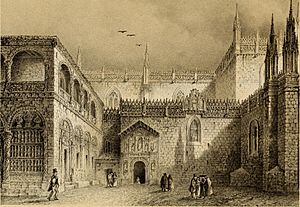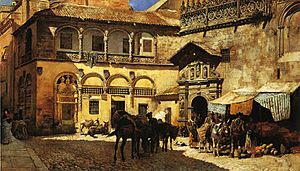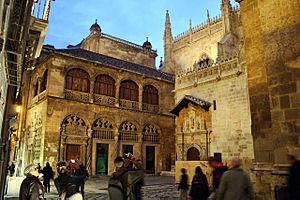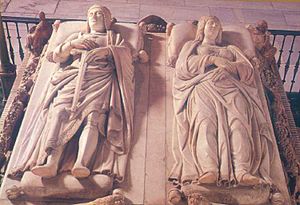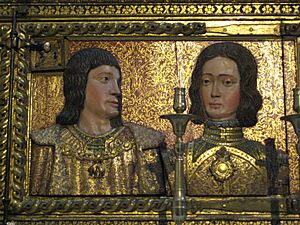Royal Chapel of Granada facts for kids
The Royal Chapel of Granada (which in Spanish is called Capilla Real de Granada) is a special building in Granada, Spain. It was built between 1505 and 1517. This chapel is famous because it's the burial place of two very important Spanish rulers: Queen Isabella I and King Ferdinand. They are known as the Catholic Monarchs. Besides being a tomb, the chapel also has a collection of amazing artworks and items that belonged to Queen Isabella.
Contents
History of the Royal Chapel
Granada was the last place in Spain ruled by the Moorish people. In 1492, the Catholic Monarchs took control of Granada. This event was a big part of their plan to unite Spain, known as the Reconquista (meaning "Reconquest").
On September 13, 1504, Queen Isabella and King Ferdinand decided they wanted to be buried in Granada. They issued a special order for the Royal Chapel to be built there. The order said they wanted an "honest chapel" in the Cathedral of Granada for their bodies. This chapel would be called "Of the Kings" and dedicated to Saint John the Baptist and Saint John the Evangelist.
The Royal Chapel was built in a style called Isabelline Gothic. This happened between 1505 and 1517. Enrique Egas was in charge of the building work. Other important builders like Juan Gil de Hontañón also helped.
The chapel was finished during King Ferdinand's lifetime. It became even more important under his grandson, Emperor Charles V. The church was decorated, and its supporting groups grew. The Royal Chapel was the main burial place for the Spanish royal family for many years. This continued until King Philip II built a new royal burial site called El Escorial.
Today, the Royal Chapel is one of the most popular places for tourists to visit in Granada. It has recently been restored. This means it was carefully repaired and cleaned. Many groups helped with this, including the Ministry of Culture of the Junta de Andalucía.
Architecture and Design
The inside of the Royal Chapel looks similar to the Monastery of San Juan de los Reyes in Toledo. It has four smaller chapels on the sides. This design forms the shape of a Latin cross. The main part of the chapel has a beautiful Gothic ceiling with ribbed vaults. The choir area has a central arch and a crypt below.
The way light enters the main area, called the presbytery, is very special. It creates a bright effect. This was meant to symbolize the sun and the light of justice. A large, decorated metal screen, made by Bartolomé Ordóñez, separates the main area from the tombs.
In the middle of the chapel are the tombs of Isabella and Ferdinand. These were made by Domenico Fancelli. There are also tombs for Joanna of Castile (Isabella's daughter) and her husband, Philip I. These were made by Bartolomé Ordóñez. The tombs are placed high up, showing how important these rulers were. They are almost as high as the altar, which shows their closeness to God.
What You Can See Inside
Inside the Royal Chapel, you can see the graves of:
- Isabella I of Castile, who was the Queen of Castile.
- Ferdinand II of Aragon, who was her husband and King of Aragon.
In another tomb, you'll find:
- Joanna of Castile, also known as "the Mad," who was Queen of Castile and Aragon.
- Philip I of Castile, also known as "the Handsome," who was her husband and King of Castile. His heart is buried in a church in Bruges, Belgium.
In the crypt, which is an underground room, there is also the tomb of Prince Miguel da Paz. He was the grandson of the Catholic Monarchs and died when he was a child.
The most important parts of the chapel are its main altar, the beautiful metal screen, and the crypt. In the crypt, there are five lead coffins. These hold the remains of the kings and the little prince. Each coffin has the first letter of their name on it, so you can tell who is who.
The chapel is still used for Catholic church services. Because of this, it is sometimes closed to tourists.
You can also visit the Sacristy-Museum. This museum holds many items that belonged to the Catholic Monarchs. It has a wonderful collection of paintings from different art schools, including Flemish, Italian, and Spanish. You can see works by famous artists like Juan de Flandes and Hans Memling. There's even a rare painting by Sandro Botticelli called Agony in the Garden. Other artists from the 15th century, like Rogier van der Weyden and Perugino, also have paintings there.
The museum also displays special gold items. These include the crown and the scepter that belonged to the Catholic Monarchs. You can also see some of Queen Isabella's old fabrics and books.
Next to the Royal Chapel, there is a building called the Lonja. It was built in 1518 and was used for banking and trade. It has also been restored recently. You can visit it to see its interesting architecture, like its facade and decorated ceilings. It also has old paintings and furniture on display.
Music Directors
For many centuries, the Royal Chapel had special music directors, called "maestros." Their job was to write music for church services and make sure it was performed well. They also taught the choirboys, who were called infantillos or seises. These maestros also took care of the chapel's music library.
To become a maestro, musicians had to take difficult tests. These tests checked their skills in composing music and their knowledge of music. Only truly talented artists could pass these exams.
One important music director was Antonio Cavallero. He started in 1757 and worked there until around 1822. Other notable music directors included Rodrigo de Ceballos and Ambrosio Cotes.
External links
- Capilla Real Granada
See also
 In Spanish: Capilla Real de Granada para niños
In Spanish: Capilla Real de Granada para niños


